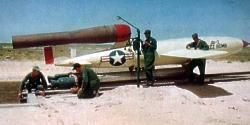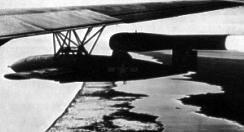
Home - Search - Browse - Alphabetic Index: 0- 1- 2- 3- 4- 5- 6- 7- 8- 9
A- B- C- D- E- F- G- H- I- J- K- L- M- N- O- P- Q- R- S- T- U- V- W- X- Y- Z
Loon
 JB-2 |
AKA: SSM-N-1. Status: Retired. Payload: 940 kg (2,070 lb). Gross mass: 2,278 kg (5,022 lb). Height: 8.26 m (27.09 ft). Span: 5.40 m (17.70 ft).
In July 1944 a crashed V-1 cruise missile was inspected by the US Army Air Force. In late 1944 a decision was taken to manufacture 75,000 American copies as the JB-2. Orders for 12,000 were placed for use against the Japanese home islands. Modifications to the German design included rail launch using a JATO solid rocket motor rather than a catapult. However the planned invasion of Japan became unnecessary after Japan's surrender in August 1945. Further production was cancelled with 1400 JB-2's completed. After the war development of an improved radio-command guidance system for the missile with a 400 m CEP was undertaken. However new turbojet- and ramjet-powered cruise missiles – the Mace, Matador, and Navaho – were in development with much greater performance. JB-2's were used only as test vehicles, the last flying in 1949.
The Navy also tested JB-2's under the Loon name. Consideration was given to equipping submarines and escort carriers with the missiles. Submarines were converted with external Loon shelters and rail launchers. The submarines had to surface to launch the missile, and test launches were conducted from 1946 to 1950. As in the case of the Air Force, no production was undertaken since the Navy was developing a much more capable turbojet-powered cruise missile, the Regulus, for the naval cruise missile role.
Maximum range: 240 km (140 mi). Boost Propulsion: Torpedo. Maximum speed: 710 kph (440 mph). Initial Operational Capability: 1947.
Historical Essay © Andreas Parsch
Willys-Overland JB-2-KGW-KUW-LTV-A-1-LTV-N-2 Loon
In July 1944, the U.S. Army Air Force had the opportunity to inspect the remains of a crashed German V-1 (Fieseler Fi 103) cruise missile, and within weeks decided to mass-produce an exact copy of the weapon as the JB-2. The first JB-2 test vehicles were built directly by the USAAF at Wright Field, but in 0ctober 1948, a JB-2 airframe production contract was awarded to Republic while Ford was to build the JB-2's PJ31-F-1 pulsejet engine. However, most JB-2s were actually built by Willys-Overland under subcontract from Republic.
The JB-2 was almost identical to the German V-1, except for the launching method and (in later missiles) the guidance system. Because the pulsejet worked only in forward flight, the missile had to be boosted into the air. The Germans used a rocket catapult, but this was considered as too dangerous by the USAAF. Several techniques were tested, and the final solution was to propel the JB-2 along a ramp with the help of a solid-propellant rocket booster. Until the end of 1944, the majority of launch attempts failed, but by early 1945 the launch problems were essentially solved. A few JB-2s were also air-launched from modified B-17 aircraft. The German V-1 and the original JB-2 used a very primitive guidance method, in which the pulsejet was stopped after a preset time leading to a dive of the missile on the target. Because this was extremely inaccurate, the USAAF began to test a radio-command guidance in early 1945. The JB-2 was equipped with a radar beacon to facilitate tracking, and a remote control operator could send guidance commands for course corrections and to initialize the terminal dive. While significantly more accurate than the original system, the average error was still 400 m (1-4 mile) at 160 km (100 miles) range under optimal conditions.
In late 1944, the USAAF had plans to procure up to 75000 JB-2s with a peak rate of several 100 per day. Eventually orders for 12000 missiles were placed, to be used for mass attacks prior to the expected invasion of Japan. The latter never materialized, and so all remaining orders were cancelled at the end of the war after about 1400 JB-2s had been built. Post-war some of the JB-2s of the USAAF were used as test vehicles for guided missile launch technology, and as such were redesignated LTV-1 in late 1947 and then LTV-A-1 in early 1948. The USAF finally ended its LTV-A-1 flight tests in 1948 or 1949.
The U.S. Navy had also shown interest in the JB-2 program from the beginning, and suggested to launch the missile from escort carriers. The Navy called the weapon the Loon and in late 1945 the designation KGW-1 was assigned to a proposed submarine-launched tactical weapon. It was briefly considered to arm the Loon with a 15 kT XW-10 nuclear warhead, but these plans were short-lived. The first launch of a KGW-1 occurred in January 1946, and in March that year the Navy approved the conversion of two submarines to Loon launch and guidance boats. However, the Loon officially became a pure research vehicle soon afterwards, and was accordingly redesignated KUW-1. The launches of KUW-1 missiles from a surfaced submarine began in early 1947, and the first successful flight was the fifth one in March that year.
Loon became primarily a launch test vehicle to test and evaluate procedures for firing guided missiles from submarines, and was again redesignated as LTV-2 in September 1947 and finally as LTV-N-2 in early 1948. The LTV-N-2 program was terminated in March 1950, and some of the results were used in the development of the SSM-N-8-RGM-6 Regulus cruise missile.
SpecificationsNote: Data given by several sources show slight variations. Figures given below may therefore be inaccurate!
Data for JB-2 (LTV-A-1-LTV-N-2):
| Length | 8.26 m (27 ft 1 in) |
| Wingspan | 5.38 m (17 ft 8 in) |
| Finspan | 2.06 m (6 ft 9 in) |
| Diameter | 86 cm (34 in) |
| Weight | 2270 kg (5000 lb) |
| Speed | 685 km-h (425 mph) |
| Range | 240 km (150 miles) |
| Propulsion | Ford PJ31-F-1 pulsejet; 4.0 kN (900 lb) booster: solid-fueled rockets |
| Warhead | 900 kg (2000 lb) high-explosive |
[1] James N. Gibson: "Nuclear Weapons of the United States", Schiffer Publishing Ltd, 1996
[2] Norman Friedman: "US Naval Weapons", Conway Maritime Press, 1983
[3] Kenneth P.Werrell: "The Evolution of the Cruise Missile", Air University Press, 1985
Family: short range cruise, submarine-launched. Country: USA. Agency: Willys-Overland.
 | JB-2 |
Back to top of page
Home - Search - Browse - Alphabetic Index: 0- 1- 2- 3- 4- 5- 6- 7- 8- 9
A- B- C- D- E- F- G- H- I- J- K- L- M- N- O- P- Q- R- S- T- U- V- W- X- Y- Z
© 1997-2019 Mark Wade - Contact
© / Conditions for Use